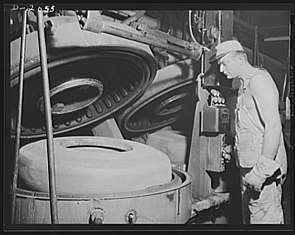Vulcanization
Vulcanization (British: Vulcanisation) refers to a range of processes for hardening rubbers.[1] The term originally referred exclusively to the treatment of natural rubber with sulfur, which remains the most common practice; however, it has also grown to include the hardening of other (synthetic) rubbers via various means. Examples include silicone rubber via room temperature vulcanizing and chloroprene rubber (neoprene) using metal oxides.

Vulcanization can therefore be defined as the curing of elastomers; with the terms 'vulcanization' and 'curing' sometimes used interchangeably in this context. It works by forming cross-links between sections of polymer chain which results in increased rigidity and durability, as well as other changes in the mechanical and electrical properties of the material.[2] Vulcanization, in common with the curing of other thermosetting polymers, is generally irreversible.
The word vulcanization is derived from Vulcan, the Roman god of fire and forge.
Overview
In contrast with thermoplastic processes (the melt-freeze process that characterize the behaviour of most modern polymers), vulcanization, in common with the curing of other thermosetting polymers, is generally irreversible. Five types of curing systems are in common use:
- Sulfur systems
- Peroxides
- Metallic oxides
- Acetoxysilane
- Urethane crosslinkers
Vulcanization with sulfur
By far the most common vulcanizing methods depend on sulfur. Sulfur, by itself, is a slow vulcanizing agent and does not vulcanize synthetic polyolefins. Accelerated vulcanization is carried out using various compounds that modify the kinetics of crosslinking,[3] this mixture is often referred to as a cure package. The main polymers subjected to sulfur vulcanization are polyisoprene (natural rubber) and styrene-butadiene rubber (SBR), which are used for most street-vehicle tires. The cure package is adjusted specifically for the substrate and the application. The reactive sites—cure sites—are allylic hydrogen atoms. These C-H bonds are adjacent to carbon-carbon double bonds. During vulcanization, some of these C-H bonds are replaced by chains of sulfur atoms that link with a cure site of another polymer chain. These bridges contain between one and several atoms. The number of sulfur atoms in the crosslink strongly influences the physical properties of the final rubber article. Short crosslinks give the rubber better heat resistance. Crosslinks with higher number of sulfur atoms give the rubber good dynamic properties but less heat resistance. Dynamic properties are important for flexing movements of the rubber article, e.g., the movement of a side-wall of a running tire. Without good flexing properties these movements rapidly form cracks, and ultimately will make the rubber article fail.
Vulcanization of polychloroprene
The vulcanization of neoprene or polychloroprene rubber (CR rubber) is carried out using metal oxides (specifically MgO and ZnO, sometimes Pb3O4) rather than sulfur compounds which are presently used with many natural and synthetic rubbers. In addition, because of various processing factors (principally scorch, this being the premature cross-linking of rubbers due to the influence of heat), the choice of accelerator is governed by different rules to other diene rubbers. Most conventionally used accelerators are problematic when CR rubbers are cured and the most important accelerant has been found to be ethylene thiourea (ETU), which, although being an excellent and proven accelerator for polychloroprene, has been classified as reprotoxic. The European rubber industry has started a research project SafeRubber[4] to develop a safer alternative to the use of ETU.
Vulcanization of silicones
Room-temperature vulcanizing (RTV) silicone is constructed of reactive oil-based polymers combined with strengthening mineral fillers. There are two types of room-temperature vulcanizing silicone:
- RTV-1 (One-component systems); hardens due to the action of atmospheric humidity, a catalyst, and acetoxysilane. Acetoxysilane, when exposed to humid conditions, will form acetic acid.[5] The curing process begins on the outer surface and progresses through to its core. The product is packed in airtight cartridges and is either in a fluid or paste form. RTV-1 silicone has good adhesion, elasticity, and durability characteristics. The Shore hardness can be varied between 18 and 60. Elongation at break can range from 150% up to 700%. They have excellent aging resistance due to superior resistance to UV radiation and weathering.
- RTV-2 (Two-component systems); two-component products that, when mixed, cure at room-temperature to a solid elastomer, a gel, or a flexible foam. RTV-2 remains flexible from −80 to 250 °C (−112 to 482 °F). Break-down occurs at temperatures above 350 °C (662 °F), leaving an inert silica deposit that is non-flammable and non-combustible. They can be used for electrical insulation due to their dielectric properties. Mechanical properties are satisfactory. RTV-2 is used to make flexible moulds, as well as many technical parts for industry and paramedical applications.
See also
References
- Akiba, M (1997). "Vulcanization and crosslinking in elastomers". Progress in Polymer Science. 22 (3): 475–521. doi:10.1016/S0079-6700(96)00015-9.
- James E. Mark, Burak Erman (eds.) (2005). Science and technology of rubber. p. 768. ISBN 0-12-464786-3.CS1 maint: extra text: authors list (link)
- Hans-Wilhelm Engels, Herrmann-Josef Weidenhaupt, Manfred Pieroth, Werner Hofmann, Karl-Hans Menting, Thomas Mergenhagen, Ralf Schmoll, Stefan Uhrlandt “Rubber, 4. Chemicals and Additives” in Ullmann's Encyclopedia of Industrial Chemistry, 2004, Wiley-VCH, Weinheim. doi:10.1002/14356007.a23_365.pub2
- SafeRubber, an alternative accelerator to the development of rubber
- "MSDS for red RTV-Silicone" (PDF). Retrieved 24 June 2011.